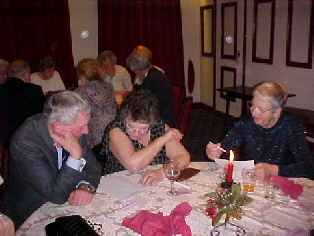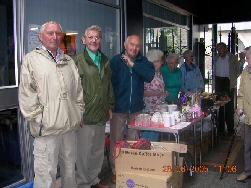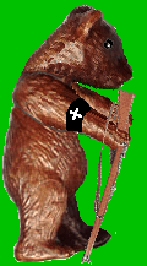Museum Lectures
Our Programme Secretary, Marge Selway, has once again put together a varied programme so please make every effort to come along, and bring a friend or relative.
Christmas Fayre
This will be on Saturday 8th November at Ebenezer so please make an early start with sorting out items for the usual range of stalls (handicrafts, bric a brac, toys, bathroom, books etc) as well as items for the bran tub, crackers and raffle prizes. We will need helpers to man the stalls so please let Peggy know if you can help.
Museum Society Social Evening
This promises to be a real treat! Please come along to the Commercial on Tuesday 25th November at 7.00pm for an evening of fun and entertainment. Tickets £3 including light refreshments.
Fund-raising July - £187
100 Club
To be drawn at the September lecture
Diary Dates
Wednesday 3rd September 2008 – Merthyr Artist 1900 by Scott Reid
Wednesday 1st October 2008 – James Green of Llansantffraed 1759 -1814 by John Evans
Wednesday 5th November 2008 - Coal Shipping at South Wales Ports by Tony Jukes
Saturday 8th November 2008 – Christmas Fayre
Tuesday 25th November 2008 –Museum Society Social Evening at The Commercial
Wednesday 3rd December 2008 – A Woman’s Lot in Tudor and Stuart Times by Susanne Allen
Lectures start at 7.00pm in the Metropole Theatre, with teas and a chat downstairs in the Museum afterwards. Entry is £2 and the public are most welcome.
You may also be interested in the following events organised by the Gwent County History Association:
Saturday 6th September - Day School: Coal Mining in Monmouthshire, at Big Pit. Call 01633 660830 for more details.
Saturday 11th October - Day School: The Towns of Medieval Monmouthshire, at the Memorial Hall, Usk. Call 01633 660830 for more details.
Saturday 1st November - Chartist Day School. Call 01633 660830 for more details.
Friday 7th November - Gwent County History Association Lecture and Supper Evening at Cefntilla. Call 01633 660830 for more details.
Poet’s Corner
‘When We Look Over the Wall’
When we are small a wall looks tall
And we wonder what’s beyond –
A shining tree, a sparkling sea –
Will we ever see?
As we grow, we partly know
Through love twixt man and wife,
In that fond bond do we glimpse beyond
An even better life?
As we grow old, with bodies cold,
Our sight begins to swim. Again we shrink
And there seems no chink in the wall
That’s tall and dim.
Then at life’s end we meet a friend
Who, because he loves us all,
With hands that tend and heal and mend,
Will make our souls grow tall.
So we can look over the wall!
Janet M. Preece April 2008
Hedggocks – 4d a time
Hidden away in the Monnow Valley near Craswall, on the far eastern side of the Black Mountains, is the little church of St Mary’s. A typical border church it is quite plain and squat with a low weather boarded bell turret. It is lovingly cared for and with the help of a little leaflet on sale in the church there are some gems to be seen. The leaflet also contains some items taken from the record books including the payments for items such as fencing the chapel yard, cloth for communion tables, items for the schoolroom and so on. The records also included the following items:
1826 pd. Benjamin Davis for killing a hedggock 4d
1828 Philip Watkins killing 4 hedgocks 1/4d
Why were people paid the princely sum of 4d for killing a hedgehog? It seems that it dates back to Tudor times when a law was passed requiring various species of animals – listed as vermin – to be killed, with a reward for the kills carried out. Apparently millions of animals were killed as a result. Hedgehogs attracted one of the highest payments as it was thought they sucked milk from cows. Does anyone know when this practice died out?
Cordell Festival 14th September
This year’s Cordell festival is to be held on Sunday 14th September at Goytre Wharf (near Llanover between Abergavenny and Pontypool). Admission is free and there will be something to suit all tastes including walks and talks with a historical slant, canal and boat display, boat trips, craft stalls and demonstrations, food fair, dance and entertainment, readings by Roy Noble and various games and so forth for children. Most of the festival will take place under cover so don’t let poor weather put you off.
Is that onion really Welsh?
The National Botanic Garden of Wales (NBGW) is introducing Welsh and English common names to the labels of plants in the Apothecaries’ Garden but the Welsh Onion is proving tricky. The term ‘Welsh’, derived from the old English ‘welisc’ means foreign and refers to the plant’s origins in East Asia where it is still an important culinary plant. And so, the plant is not really ‘Welsh’ but ‘welsh’. This exerpt is taken from the magazine produced by the Botanic Garden where the full article reveals the dilemma facing the NBGW members as to quite what they should call the plant we all know as ‘Welsh Onion’.
Local Voices
‘My First Job’
In 1941 I passed my ‘Matric’. This was the exam taken at the end of the fifth year in the County School. One had to pass ALL the subjects in one go. If you failed one you had to sit the whole 7 or 8 subjects the next year. Thankfully I passed all at the first try. I was never given any career advice and although I toyed with the idea of going to teacher training college, I really did not want to do any more intensive studying. My father would not let me leave school just to take any sort of job, and so I started teaching myself shorthand and book-keeping. After a couple of months I applied for a job in the Food Office and I was successful. The Food Office was situated in Carmel Street and was the original building known as The Snowdon Café. This is now the premises of the Sports Club. I think about 14 people were employed there.
The work was clerical. Part of my duties involved issuing new ration books and identity cards. Every person had to register with a grocery shop and butcher who in turn brought the weekly coupons to the Food Office, where they were counted for the various commodities and a permit issued for that amount. How boring that seems now. In those days there were many grocery shops e.g. Maypole, Direct, India and China, Liptons, Home and Colonial, Coop, Rees’, Price’s and John Bull as well as many corner shops. There was a lot of filing to do which was one thing that has held me in good stead.
Regarding the butchers’ shops, all the meat was rationed but occasionally offal, sausages and faggots were available which the butcher gave out as he thought was fit and fair according to the number in the family. Although the Jewish population was not high in Abertillery they were catered for and there was a Kosher butcher in the town. This again was accounted for separately.
In those days butter, cheese, margarine, sugar, bacon etc was not pre-packed like today and the shops were given a small percentage cutting up allowance. I forget the actual amounts we were allowed but it was something like 2ozs butter, 2ozs margarine, 2ozs sugar, 1oz tea, 4ozs bacon (which incidentally often tasted fishy due to pigs being fed fish parts). Cheese was quite plentiful as the majority of the male population consisted of miners and in essential occupations; they could not be called for military service as coal mining was the backbone of the war effort. Due to the heavy physical demand on these men they were allowed a large cheese ration which was often passed on to others if not all was needed.
I don’t know what happened to unions in those days, but as young people we often worked long hours. During the weeks when new ration books were issued we worked till 8 o’clock at night with NO OVERTIME PAY!!! I think the pay was about £3.00 per week.
When dances were held in the Market hall my friend and I would take our glad rags to work, change in the office and go to the dance after work.
Rationing went on long after the war had ended and I was always asked by my ex boss if I would like to work for a few weeks when new ration books were being issued. I was married and a mother by this time but I enjoyed going back to work for a few weeks while my mother looked after my young daughter.
I have had several jobs since then but the friendships formed in my first job never ended except sadly by the death of some of my close work mates.
Enid Dean “Jobless in 2008”
Book Corner
The Gwent County History. Vol. 2 - The Age of the Marcher lords, c1070 – 1536 (Edited by R.A. Griffiths, T. Hopkins & R. Howell)
Volume 2 of the Gwent County History has now been published under the title “The Age of the Marcher Lords c1070-1536”. The period covered is one of the most turbulent in the history of South East Wales. There were more Marcher Lordships in this area than anywhere else in the Welsh Marches and the actions of the marcher Lords and the events in which they were involved had a major impact on the development of the area.
The various chapters by different authors deal with the social, economic and religious history of the period and cover the changes in society and politics leading up to the Union of England and Wales. Some of the great buildings found in Gwent date from this period e.g, Tintern Abbey and Raglan Castle.
The volume ends in 1536 when Monmouthshire was created and explains the choice of name and how the boundaries were drawn. Theses boundaries remained in place until the re-organisation of Local Government in1974.
An appendix chapter is included to deal with the discovery of the medieval ship in Newport. There are many illustrations and an excellent collection of maps which add to its value for students and the general reader.
Further volumes of this history are well advanced towards publication.
Jean Colwell
MUSEUM MATTERS
Obituary
Bernard Dyer an Officer and a Gentleman
 An Officer and a Gentleman, never have these words been more appropriate than when describing Bernard Dyer.
An Officer and a Gentleman, never have these words been more appropriate than when describing Bernard Dyer.
Bernard served our society as a Trustee, Director and on the Management Committee.
Bernard was a hands on worker in every respect, not only involved in the continuous fundraising but also in other essential work for the museum. He would use his estate car not only for boot sales but also to transport artefacts such as a kitchen fireplace which we first had to remove from a house in Cwmtillery.
On one occasion we had transported an exhibition to a venue in Beaufort where unknown to us the occasion was also in fancy dress. When one lady entered the room spouting a moustache his dry humour showed with the remark, "Looks like she's forgotten to shave this morning".
His sense of humour and his gentlemanly conduct was an inspiration to everyone who knew him.
One memory that I have of him is when the Abertillery Burma Star Organisation presented their Standard to the museum. I wanted this to be a special ceremony and tried to remember how a standard was presented when I was in the Sea Cadets.

After the ceremony Bernard who was an Officer in the Royal Navy before he transferred to the army came up to me. Putting his hand on my shoulder he said, "That was well done".
For an instant I felt that I was back on the Quarterdeck receiving a compliment from an Officer for carrying out my duty.
These words meant all the more to me because of who had said them.
When Margaret phoned to tell us of Bernard's passing she said that he had suffered.
 I believe it was a release and this may in some way lesson our grief, my faith gives me consolation but for others remember. No one truly dies they live on in the thoughts and memories of the people whose lives they have touched and in the deeds they have done.
I believe it was a release and this may in some way lesson our grief, my faith gives me consolation but for others remember. No one truly dies they live on in the thoughts and memories of the people whose lives they have touched and in the deeds they have done.
Bernard Dyer donated his Service Uniform and his Dress Uniform to the museum, when there are military exhibitions held in the museum they are and will be proudly on display so that future generations will know his name.

Margaret and her family know how we all feel about him; the fact that he was not well enough to attend the opening of the museum after the refurbishment was regretted by everyone.
 Our thoughts are with Margaret and her family, Bernard was one of the Old School, an Officer and a Gentleman in every respect.
Our thoughts are with Margaret and her family, Bernard was one of the Old School, an Officer and a Gentleman in every respect.
Don Bearcroft Curator
Top Of Page
